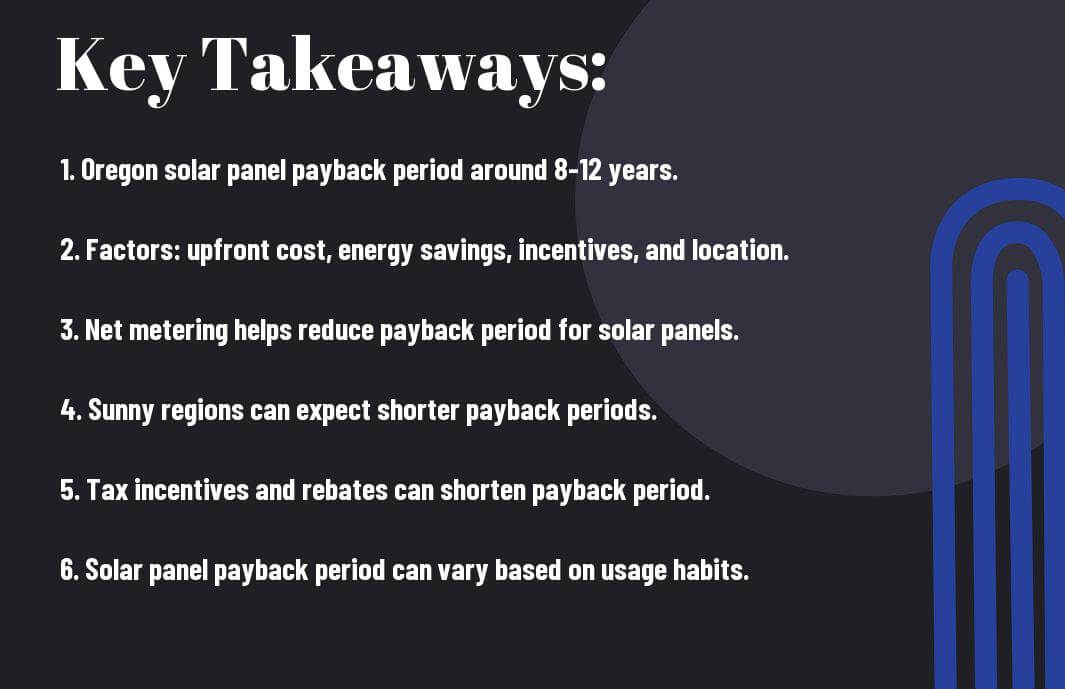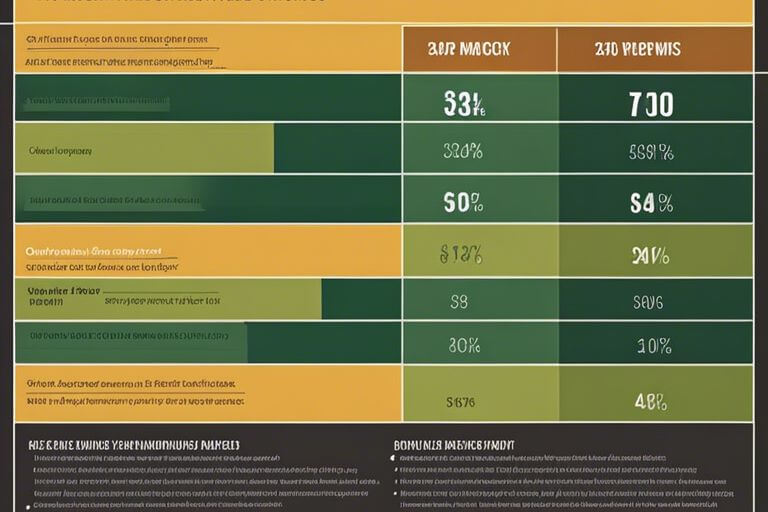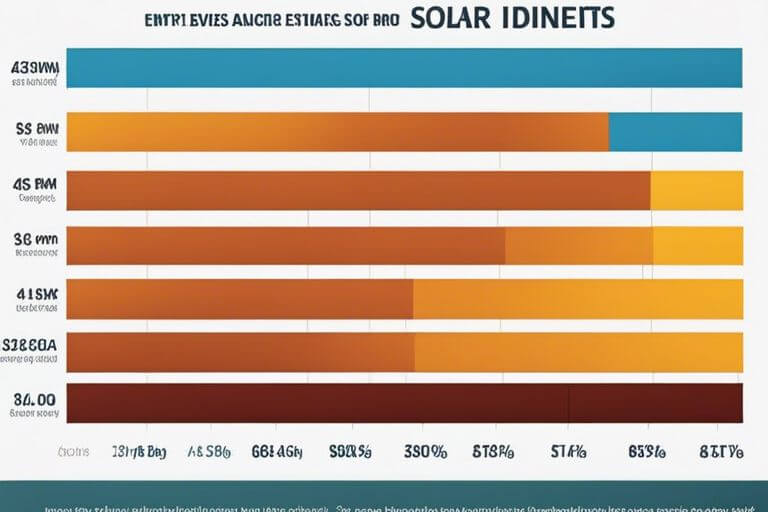You may be wondering, how long will it take for your investment in solar panels to pay off in Oregon? The payback period for solar panels in Oregon typically ranges from 6 to 12 years, depending on various factors such as the specific location of your home, the size of your solar system, available incentives, and your energy usage. By understanding the payback period, you can make an informed decision about whether solar panels are a worthwhile investment for your home in the Beaver State.
Key Takeaways:
- Solar panel payback period: The average payback period for solar panels in Oregon is around 8 to 10 years.
- Factors influencing payback period: The payback period can vary based on factors such as location, energy consumption, available incentives, and the cost of installation.
- Long-term savings: Despite the initial investment, solar panels can lead to significant long-term savings on energy bills and potentially increase the value of your home.


Benefits of Solar Panels in Oregon
The Oregon Solar Panel Cost Guide for 2024 can provide you with valuable insights into the financial aspects of installing solar panels in Oregon. But beyond the financial considerations, there are several other benefits of solar panels in the Beaver State.
Environmental Advantages
With solar panels, you can significantly reduce your carbon footprint and help combat climate change. By generating clean, renewable energy from the sun, you can lower your reliance on fossil fuels and decrease harmful greenhouse gas emissions. In Oregon, where environmental conservation is a priority, installing solar panels can align with your values and contribute to a more sustainable future for the state.
Economic Incentives
Economically, investing in solar panels can lead to long-term savings on your energy bills. In addition, Oregon offers various incentives to make solar more affordable, such as tax credits, rebates, and net metering programs. These economic incentives can help offset the initial costs of installing solar panels and improve the payback period, making it a smart financial decision for Oregon residents.
Another economic benefit of solar panels in Oregon is the potential to earn money through net metering. With net metering, you can sell excess energy generated by your solar panels back to the grid, further lowering your electricity costs and potentially even turning your energy bill into a source of income.
Calculating the Payback Period
There’s a simple way to determine the payback period for solar panels in Oregon. By taking into account various factors affecting the payback period, you can get a good estimate of when you’ll start seeing a return on your investment.
Factors Affecting Payback Period
- The cost of your solar panel system
- The amount of sunlight your location receives
- Your current electricity rates
- The incentives and rebates available to you
The payback period will be shorter if you have higher electricity rates, ample sunlight, and generous incentives. The sooner you break even on your initial investment, the more savings you’ll see over the lifespan of your solar panels.
Formula and Calculation
For the calculation, you can use the simple formula:
Payback Period = Total Cost of Solar System / Annual Savings on Electricity
The payback period represents the number of years it will take for your electricity savings to equal the total cost of the solar panel system. Understanding this formula is crucial in determining when you will start to benefit financially from your investment in solar panels.
Average Payback Period in Oregon
Once again, when considering the payback period for solar panels in Oregon, it is important to look at both residential and commercial scenarios.
Residential Solar Panels
Payback periods for residential solar panels in Oregon typically range from 6 to 10 years. Several factors can influence this timeline, including the size of your solar system, available incentives, and your electricity usage. By generating your electricity and potentially selling excess power back to the grid through net metering, you can accelerate the payback period of your investment.
Commercial Solar Panels
On the commercial side, the payback period for solar panels in Oregon can vary widely depending on your business’s energy needs and financial incentives available. With potential tax benefits, rebates, and accelerated depreciation, many businesses in Oregon are seeing payback periods of 3 to 7 years for their solar installations.
Another important consideration for commercial solar panels is the potential for long-term savings beyond the payback period. By reducing your reliance on traditional energy sources and locking in lower energy costs for years to come, solar panels can continue to provide significant financial benefits for your business well after the initial investment is recouped.

Factors Influencing Payback Period in Oregon
Keep these factors in mind when considering the payback period for solar panels in Oregon:
- Initial Investment Costs
- Energy Savings
- Local Incentives and Rebates
Initial Investment Costs
Any solar panel system requires an initial investment for purchase and installation. The size of your system, the type of panels you choose, and the complexity of installation can all impact the initial cost. However, it’s crucial to remember that this upfront expense is offset by the savings you will enjoy over time through reduced electricity bills. This is a crucial factor to consider when calculating the payback period for your solar panels.
Energy Savings
Savings from your solar panel system come from generating your electricity rather than relying solely on the grid. By harnessing the power of the sun, you can significantly reduce your monthly electricity costs. The amount you save will depend on factors such as your energy consumption, the efficiency of your system, and the amount of sunlight your location receives.
Influencing the payback period, these energy savings play a vital role in offsetting the initial investment costs of your solar panel system.
Local Incentives and Rebates
Energy incentives and rebates offered by local and state governments can significantly impact the financial equation of installing solar panels. In Oregon, you may be eligible for various incentives that can help lower your upfront costs or provide ongoing financial benefits. These incentives can include tax credits, rebates, and performance-based incentives.
With the availability of these local incentives and rebates, the payback period for your solar panel system in Oregon can be further shortened, making it a more attractive investment option.
Comparing Payback Periods Across Oregon
After calculating the payback period for solar panels in Oregon, you might be curious about how it varies across different regions in the state. Let’s take a closer look at the differences you might encounter.
| Urban Areas | Rural Areas |
| In urban areas such as Portland or Eugene, where electricity rates are typically higher and there is more sunlight exposure, the payback period for solar panels may be shorter. The higher energy demand and potential for larger energy savings can make investing in solar panels more financially beneficial. | Rural areas, on the other hand, may have lower electricity rates and less sunlight exposure compared to urban areas. This could result in a slightly longer payback period for solar panels. However, with fewer shading obstacles and potentially more space for larger solar installations, the long-term benefits of solar panels can still make them a worthwhile investment. |
Rural Areas
Rural areas in Oregon may have unique characteristics that influence the payback period for solar panels. Factors such as lower electricity rates, fewer shading obstacles, and available incentives can all play a role in determining how quickly you can recoup your initial investment in solar energy.
Different Cities and Regions
With diverse cities and regions across Oregon, the payback period for solar panels can vary significantly. For example, coastal cities like Astoria may experience more cloud cover and less sunlight compared to central Oregon cities like Bend, where there is abundant sunshine. These regional differences can impact the efficiency and financial feasibility of solar panel installations in your area.
Areas with higher electricity rates, longer sunlight hours, and ample incentives for solar energy can generally result in a shorter payback period for your solar panel investment. It’s crucial to consider these regional variations when evaluating the cost-effectiveness of solar panels for your home or business in Oregon.
Maximizing Your Return on Investment
Optimal System Size and Design
Maximizing your return on investment for solar panels in Oregon starts with choosing the optimal system size and design. By carefully assessing your energy needs and consumption patterns, you can determine the right size of the solar panel system for your home. Additionally, selecting high-quality solar panels and optimizing their placement can significantly increase the efficiency and output of your system.
Energy Efficiency Measures
Energy efficiency measures play a crucial role in maximizing the return on your solar panel investment. By implementing energy-saving practices such as using energy-efficient appliances, improving insulation, and sealing air leaks in your home, you can reduce your overall energy consumption. This, in turn, will not only lower your electricity bills but also allow your solar panels to meet a larger percentage of your energy needs.
Plus, investing in energy efficiency measures can help prolong the lifespan of your solar panel system and reduce maintenance costs in the long run. By minimizing energy waste, you can optimize the performance of your solar panels and enhance the economic benefits of your investment.
Maintenance and Monitoring
Maintenance and monitoring are important aspects of maximizing the return on your solar panel investment. Regular maintenance, such as cleaning the panels and checking for any damage, can ensure that your system operates efficiently and continues to generate electricity at its full capacity. Additionally, monitoring your system’s performance through data analysis and technological tools can help you identify and address any issues promptly, maximizing the overall output and lifespan of your solar panels.
It is recommended to establish a maintenance schedule and keep track of your system’s performance to ensure optimal operation and maximize the financial returns of your solar panel investment over time.
Final Words
The payback period for solar panels in Oregon can vary based on several factors such as the cost of installation, energy usage, and available incentives. It typically ranges from 5 to 12 years, meaning that you will start to see returns on your investment within that timeframe. Additionally, with the potential increase in energy savings and the added benefit of reducing your carbon footprint, investing in solar panels can be a smart long-term financial and environmental decision for you.
So, if you are considering making the switch to solar energy in Oregon, remember that while there is an initial investment, the long-term benefits make it a worthwhile choice. By understanding the payback period and potential savings, you can make an informed decision that not only benefits your wallet but also the environment. Ultimately, investing in solar panels in Oregon is not just about saving money but also about creating a sustainable future for you and the generations to come.
FAQ
Q: What factors affect the payback period for solar panels in Oregon?
A: The payback period for solar panels in Oregon can be influenced by factors such as the cost of the solar panel system, available incentives and rebates, electricity rates, local weather conditions affecting sunlight exposure, and the efficiency of the solar panels.
Q: How long is the average payback period for solar panels in Oregon?
A: The average payback period for solar panels in Oregon typically ranges from 5 to 10 years. This can vary depending on the factors mentioned above, but many homeowners see a return on their investment within this timeframe through savings on electricity bills and potential incentives.
Q: Are there any incentives available in Oregon to shorten the payback period for solar panels?
A: Yes, Oregon offers various incentives to encourage the adoption of solar energy, such as the Residential Energy Tax Credit (RETC), the Oregon Solar Incentive Program, and the federal Investment Tax Credit (ITC). These incentives can help reduce the upfront costs of installing solar panels and shorten the payback period for homeowners in Oregon.
